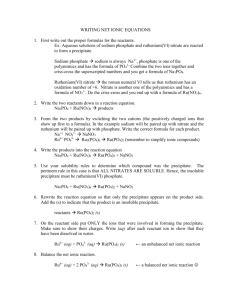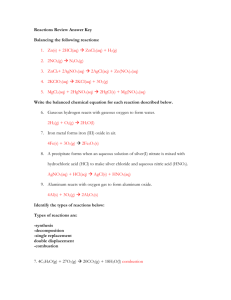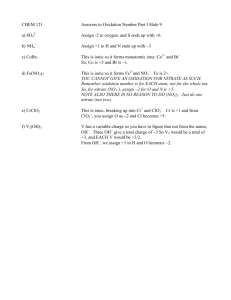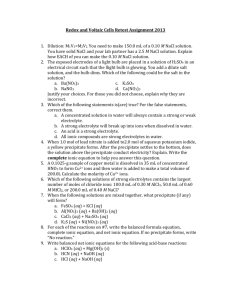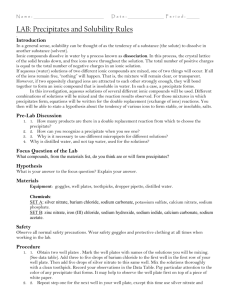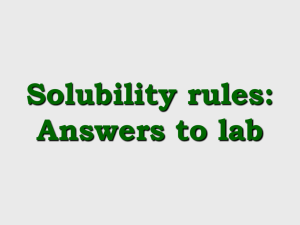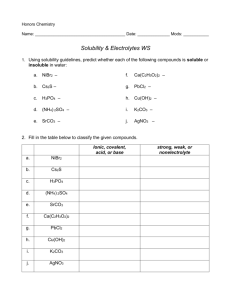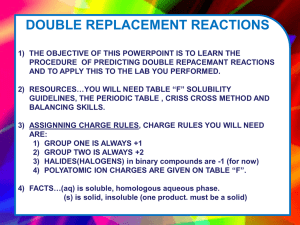Writing net ionic equations:
advertisement
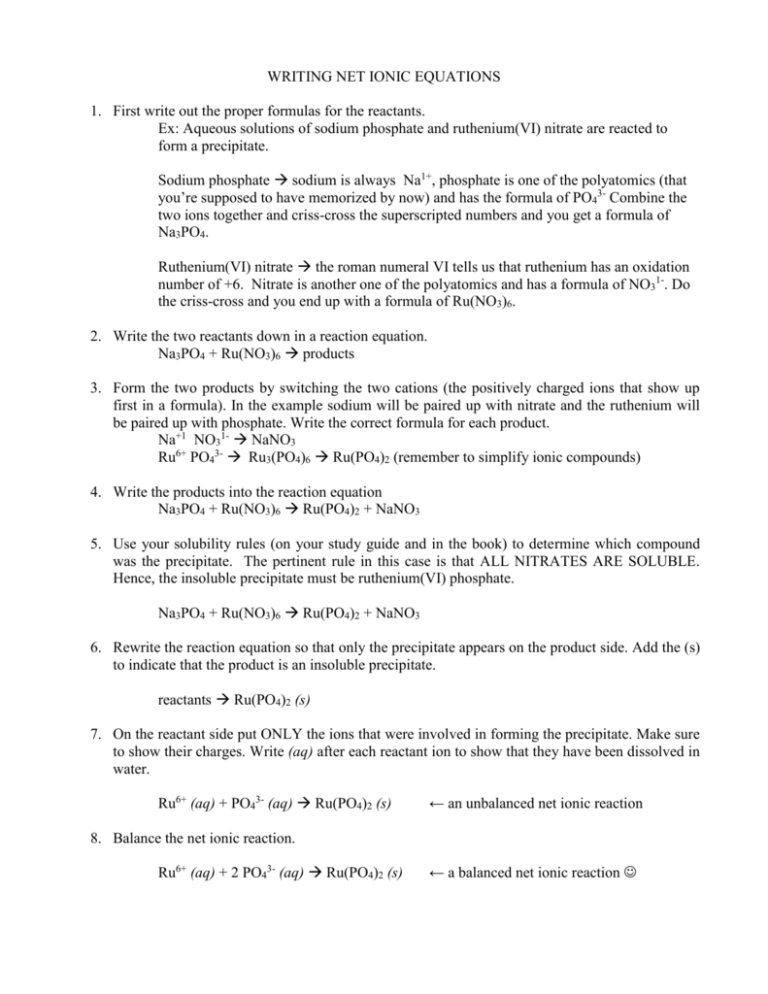
WRITING NET IONIC EQUATIONS 1. First write out the proper formulas for the reactants. Ex: Aqueous solutions of sodium phosphate and ruthenium(VI) nitrate are reacted to form a precipitate. Sodium phosphate sodium is always Na1+, phosphate is one of the polyatomics (that you’re supposed to have memorized by now) and has the formula of PO43- Combine the two ions together and criss-cross the superscripted numbers and you get a formula of Na3PO4. Ruthenium(VI) nitrate the roman numeral VI tells us that ruthenium has an oxidation number of +6. Nitrate is another one of the polyatomics and has a formula of NO31-. Do the criss-cross and you end up with a formula of Ru(NO3)6. 2. Write the two reactants down in a reaction equation. Na3PO4 + Ru(NO3)6 products 3. Form the two products by switching the two cations (the positively charged ions that show up first in a formula). In the example sodium will be paired up with nitrate and the ruthenium will be paired up with phosphate. Write the correct formula for each product. Na+1 NO31- NaNO3 Ru6+ PO43- Ru3(PO4)6 Ru(PO4)2 (remember to simplify ionic compounds) 4. Write the products into the reaction equation Na3PO4 + Ru(NO3)6 Ru(PO4)2 + NaNO3 5. Use your solubility rules (on your study guide and in the book) to determine which compound was the precipitate. The pertinent rule in this case is that ALL NITRATES ARE SOLUBLE. Hence, the insoluble precipitate must be ruthenium(VI) phosphate. Na3PO4 + Ru(NO3)6 Ru(PO4)2 + NaNO3 6. Rewrite the reaction equation so that only the precipitate appears on the product side. Add the (s) to indicate that the product is an insoluble precipitate. reactants Ru(PO4)2 (s) 7. On the reactant side put ONLY the ions that were involved in forming the precipitate. Make sure to show their charges. Write (aq) after each reactant ion to show that they have been dissolved in water. Ru6+ (aq) + PO43- (aq) Ru(PO4)2 (s) ← an unbalanced net ionic reaction 8. Balance the net ionic reaction. Ru6+ (aq) + 2 PO43- (aq) Ru(PO4)2 (s) ← a balanced net ionic reaction Net Ionic Equations Worksheet BALANCE the following equations then write the NET IONIC EQUATION for each one: 1. ____Ni(NO3)2 (aq) + ____NaOH (aq) _____ Ni(OH)2 (s) + _____ NaNO3 (aq) 2. ____ NaCl (aq) + ____ AgC2H3O2 (aq) ____ NaC2H3O2 (aq) + _____ AgCl (s) 3. ____ Ca(OH)2 (aq) + _____ H3PO4 (aq) _____ H2O (l) + _____ Ca3(PO4 )2 (s) 4. _____ BaCl2 (aq) + _____ Na2SO4 (aq) _____ NaCl (aq) + _____ BaSO4 (s) 5. _____ AgNO3 (aq) + _____ K2CO3 (aq) _____ Ag2CO3 (s) + _____ KNO3 (aq) 6. _____ MgBr2 (aq) + _____ KOH (aq) _____ KBr (aq) + _____ Mg(OH)2 (s) 7. _____ AlCl3 (aq) + _____ K3PO4 (aq) _____ KCl (aq) + _____ AlPO4 (s) 8. _____Hg2(NO3)2 (aq) + _____ CaCl2 (aq) _____Ca(NO3)2 (aq) + _____Hg2Cl2 (s) Using the solubility rules, predict the products, balance the equation, and write the complete ionic and net ionic equations for each of the following reactions. 9. _____Pb(NO3)2 (aq) + ____ Na2SO4 (aq) 10. _____AgClO3 (aq) + _____KCl (aq) 11. _____KOH (aq) + _____ Fe(NO3)3 (aq) 12. _____ZnCl2 (aq) + _____ H2S (aq) 13. _____Na3PO4 (aq) + _____ CaCl2 (aq) 14. _____ (NH4)3PO4 (aq) +_____ Zn(NO3)2 (aq) 15. _____ LiOH (aq) + _____ VCl3 (aq)
